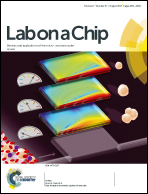Design and modeling of electrode networks for code-division multiplexed resistive pulse sensing in microfluidic devices†
Abstract
A typical microfluidic device sorts, captures or fractionates sample constituents by exposing them to discriminating microenvironments. Direct electronic acquisition of such manipulation by a network of integrated sensors can provide a fast, integrated readout, replacing otherwise required microscopy. We have recently introduced a sensor technology, Microfluidic CODES, which allows us to multiplex resistive pulse sensors on a microfluidic device. Microfluidic CODES employs a network of micromachined coplanar electrodes such that particles passing over these electrodes produce distinguishable code sequences. In this paper, we explain the design process to specifically generate an orthogonal digital code set for an efficient and accurate demultiplexing of the sensor signals. We also introduce an equivalent circuit model for a network of code-multiplexed resistive pulse sensors by utilizing the Foster–Schwan model and conformal mapping, to model dynamic cell–electrode interaction in a non-uniform electric field. Our results closely match with both experimental measurements using cell lines and finite element analysis. The coding and modeling framework presented here will enable the design of code-division multiplexed resistive pulse sensors optimized to produce desired waveform patterns to ensure reliable and efficient decoding.

- This article is part of the themed collection: RSC papers by NanoEngineering for Medicine and Biology 2018 Speakers


 Please wait while we load your content...
Please wait while we load your content...